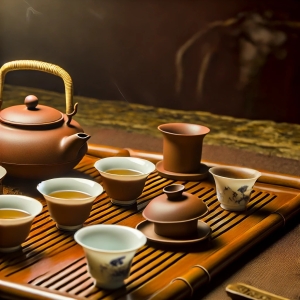Tea Traditions in Popular Culture: Exploring Tie Guan Yin Tea and Bi Luo Chun Green TeaPosted by chasourcing on August 5th, 2024  Introduction Tea, a beloved beverage, not only enjoys popularity worldwide for its refreshing flavors and health benefits but also holds a significant presence in various forms of popular culture, including anime and literature. This exploration highlights two renowned Chinese teas, Tie Guan Yin Tea and Bi Luo Chun Green Tea, as depicted in cultural works, emphasizing their unique characteristics, cultural significance, and the roles they play in storytelling. Tie Guan Yin Tea in Popular Culture Tie Guan Yin, also known as Iron Goddess of Mercy, is a premium variety of Chinese Oolong tea from Anxi in Fujian Province. It is renowned for its floral aroma and complex taste. In the world of anime and literature, Tie Guan Yin often symbolizes refinement and transformation, mirroring the intricate process of its production—where leaves undergo partial oxidation and a series of careful rollings and bakings. One notable mention of Tie Guan Yin Tea is in the Japanese anime "Rokuhoudou Yotsuiro Biyori," where a traditional tea shop serves this exquisite tea, highlighting its cultural prestige and the art of tea preparation. The anime beautifully illustrates the calming effect of the tea on the characters and, by extension, the viewers, emphasizing how the ritual of tea-making and savoring can soothe the mind and foster interpersonal connections. Bi Luo Chun Green Tea in Literary Works Bi Luo Chun, originating from the Dongting mountain region near Lake Tai in Jiangsu province, is famous for its delicate appearance and a gentle, sweet flavor that incorporates hints of fruitiness. In literature, Bi Luo Chun is often associated with purity and springtime, owing to its name meaning "Green Snail Spring." This tea is featured in various Chinese novels, where characters often enjoy Bi Luo Chun during moments of contemplation or social grace. For example, in the modern Chinese literary work "The Tea Girl of Hummingbird Lane" by Lisa See, Bi Luo Chun is presented as a symbol of heritage and delicate craftsmanship, reflecting the protagonist's deep connection to her tea-growing community. The novel uses the tea as a narrative device to explore themes of family bonds and cultural identity, illustrating the integral role of tea in Chinese social and cultural practices. Cultural Significance and Global Appeal Both Tie Guan Yin and Bi Luo Chun Green Tea hold significant places in Chinese tea culture, often used in ceremonies and social gatherings. Their inclusion in popular media not only educates audiences about the depth of tea culture but also bridges cultural gaps, inviting global viewers and readers to explore the rich traditions associated with these teas. In anime and literature, these teas are not merely beverages but are imbued with cultural values and emotional depth. They are often portrayed as catalysts for character development and plot progression, highlighting their roles in cultural rituals and personal moments of revelation. Conclusion Tie Guan Yin and Bi Luo Chun Green Tea, through their vivid portrayals in anime and literature, transcend their roles as mere consumables to become significant cultural icons. These teas contribute to the narrative landscapes of popular media, offering viewers and readers around the world a taste of Chinese tradition and the universal solace found in a cup of tea. As they continue to appear in various works of popular culture, Tie Guan Yin and Bi Luo Chun not only promote global appreciation of tea but also encourage a deeper understanding of the cultural narratives intertwined with these ancient brews. Like it? Share it!More by this author |


